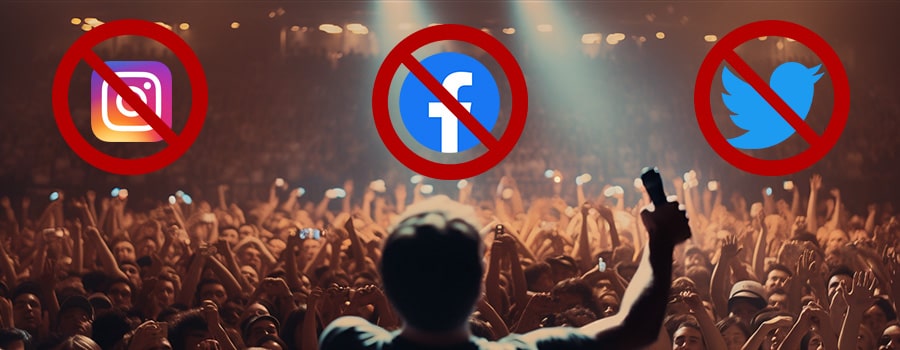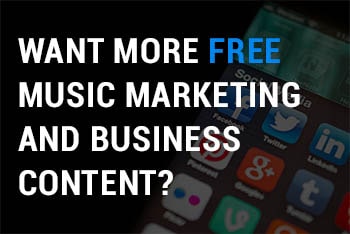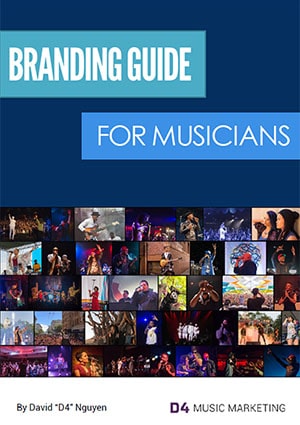
The one thing that never fails to piss off creators and artists are social media algorithms!
The days of free organic reach have been well behind us. Basically, ancient history at this point. Although the perception of how TikTok serves content to users seems to be more favorable, the complaints have more so been with Instagram and Facebook (both owned by Meta of course). To be fair, the YouTube algorithm doesn’t share your new video uploads to all of your subscribers either.
What can musicians do to overcome this challenge with algorithms? Or is it even the source of the problem in the first place? In this blog, we’ll explore that and cover a list of tactics for you to try and “beat” the algorithm.
What purpose do algorithms serve and how does it work?
I won’t go into what an algorithm is as I’m sure everyone reading is well aware of what it is, or at the least, understands how it impacts (ruins) your social media experiences as the creator.
However, I really want to emphasize an important point that gets lost in the conspiracy theory that platforms intentionally suppress the reach of certain types of posts (i.e. sales related posts). I touch more on this on another blog and explain what I believe to be the real problem.
Algorithms serve a key role in helping to provide a positive user experience on social media platforms because it addresses the problems of content saturation and low quality content. (No, I wasn’t paid by any of those platforms to say that.)
Back in the days, the newsfeed on platforms, like Facebook and Instagram, would show posts in chronological order. This was around 10 years ago before we had the number of users and content creators we have today. The more you would post, the more visibility you received. There were businesses and creators scheduling like 8 to 10 Facebook posts a day!
Algorithms were introduced in social media as a way to address the problem that we would see today… an overload and saturation of content. One of the goals of the algorithm was to encourage/force creators to only make high quality posts/content that followers would want to see and engage with.
For the longest time, the algorithm was a big mystery. People wanted to know how it worked in order to try and game the system or “beat the algorithm”. Although we didn’t know all the exact signals and ranking factors they use and weight it plays, we’ve had a good understanding of what the algorithm looks for.
In an effort to be more transparent, Instagram eventually published a blog in 2021 explaining how their algorithms work and have since updated it recently. This has given us a bit more clarity on how they rank posts and determine what gets shown in the various parts of Instagram (Newsfeed, Stories, Reels, Explore). More importantly, it has given us guidelines on what we can do to improve the reach of our posts.
What does it mean to beat the algorithm?
It’s important to first define what “beating” the algorithm even means and why so many musicians constantly seek out this information in frustration.
In social media, it’s being able to dramatically improve your organic reach to your followers on a platform for free and not having to use their ad service to get your posts seen. You can look at it as making the algorithm your friend. If you post the right video at the right time, you may see an outburst of views and engagement as the algorithm continually pushes your content to non-followers. I helped create a few viral moments for an artist thanks to the algorithm and you can read more about that campaign here.
This is particularly true when trying to sell something that would benefit you financially. The long, commonly held belief (conspiracy theory) is that the algorithm used in these platforms will automatically suppress the reach of these types of posts in order to force artists to spend money to reach their followers. I wouldn’t be surprised if it were true, but I arrived at a different conclusion.
I truly do not believe it is possible to “beat the algorithm” on any consistent basis, but there are definitely things you can do to improve your chances of getting better organic reach with your posts. Some of these tactics are features that these platforms intentionally created to help you beat the algorithm.
Tactics to improve your chances of “beating the algorithm”
Here is a list of tactics you’ll want to consider when developing your social media strategy and posting on social media if you want the best chances of getting free organic reach. It’s going to be a mix of things to do for more immediate results as well as for the long term. These tactics were not for a specific social media platform, but a lot of them are with Facebook and Instagram in mind.
1. Don’t publish “low quality” content. Let’s get the obvious out of the way. This is the low hanging fruit that everyone should be reminded of. Don’t post things half assed without much thought just to get something out there on social media. Quality matters! This does not mean it has to be “professional” quality. If you’re posting a dark, blurry photo of something that doesn’t even have a clear subject, don’t expect to get much engagement. If you post a busy, ugly graphic full of text, don’t get mad that the algorithm is shadow banning you. If the video audio has obnoxiously static noises and you can’t even make out the words, that will not get reach because people will scroll past it.
2. Ask or incentivize followers to turn on post notifications or add you to their ‘favorites list’. One sure way to get your posts ranked on top of someone’s newsfeed is asking followers to ‘turn on the notifications’ to get a push notification whenever you post. All the major platforms have this option to some effect. By default on Instagram, followers will only get a notification for some live videos. You can also ask them to add you to their favorite’s list which allows all your posts to be at the top of their newsfeed. Some of your biggest fans may have already done this on their own without you asking. I know I’ve done that with my top favorite artists. However, you may have to incentivize them to do so. Maybe if you did a random giveaway for show tickets or merch. Or you can announce a limited edition merch drop coming soon so “turn on post notifications for my posts and add me to your favorite’s list to to be the first to know before it sells out.”
3. Pay attention to what’s trending. Always keep an eye out on what’s trending on social media and in the news. Each platform will have their way of informing you of what’s trending. You also see search trends on Google. Whether it’s a new challenge or capitalizing on a story going viral, you want to take advantage of the increased wave of attention and try to ride it if it makes sense for you. This is also a great source of ideas for creating content to help build your fan base.
4. Vary the content mediums. The general consensus is that video content is generally more engaging than a photo. They’re both equally effective, but it really comes down to what your goals are with a post. If you’re trying to get more shares and reach new potential fans, then video would work better. Even a funny, motivational or relatable text quote graphic (for example, a screenshot of a tweet) can be highly engaging and shared. But the reason why you want to vary your content mediums (photo, video, audio, text) is because not all of your followers are the same. More specifically, not everyone that follows you is a die hard fan. Some may just casually know of you while some just like you for something that’s totally unrelated to music. This is why content variation and consistency is key. In the same token, not all of them prefer to engage with videos. Some may have a stronger history of engaging more with photos so the algorithm will more likely rank photo posts higher in their newsfeed. Because every fan is going to be different in how the algorithm understands their connection to you, you want to make sure you’re not limiting yourself to one medium.
5. Optimize your posts. Very simple and basic. Do your best to optimize your posts with a good caption that is appropriate, engaging thumbnails, include emojis, add a location if applicable and tag the appropriate people if they are actually visibly in the post. Never randomly tag people in your posts as that can be grounds for a penalty in the algorithm.
6. Send the right signals. Using hashtags, location tags and keywords naturally (as in, don’t force or overdo it) in your captions to signal what your content is about so that the algorithm can suggest your posts to the right people. These platforms want to use every little detail about your post from the text in the caption to the actual media contents to understand what it is about and who would be interested in that topic.
7. Optimizing your video content for a short attention span. For short form videos, you can optimize it in how it is edited by getting into the action quicker and avoiding long intros. If you’re posting a snippet of your music video, don’t start at the very beginning and jump into a chorus or the most visually interesting part. You may also want to consider doing things at the very beginning to get attention like a video effect and stop the scroll. This also means you are using text captions in your videos, which have become more increasingly popular in TikTok and Instagram the past few years now. Many people will actually watch with the sound off because they may be in the situation where they can’t have the sound on.
8. Post at the “right” time. Timing is everything. You’re never going to get it right every single time. With some trial and error, you’ll eventually get a good feel for what is optimal. Every social media audience is different so the best times are not going to be the exact same for everyone. But whatever you do, do not delete a post if you’re not seeing engagement right away. It’s better to leave it and post it another day and time. You wouldn’t want to make the mistake Noah Kahan almost made when he nearly deleted the TikTok video that eventually went viral. For help and guidance for how to find the best times to post on social media, you can refer to my blog.
9. Post multiple times. Depending on what it is that you’re posting and what your objective is, it makes sense to post the same piece of content multiple times. I wouldn’t do it back to back but I would experiment at different times and days. Because so many factors are involved, you can’t just assume that something doesn’t do well because of the “algorithm” or your content sucks. Also, don’t forget to give your content time to run its course. Because recency plays a role in how content is ranked, at least with Instagram, wait at least 12 to 24 hours until posting anything else after.
10. Try long form captions. It’s true that most people generally don’t read very long captions. And yes, a lot of the posts that I see that get tons of engagement or often very short and snappy, witty captions. But long form can work in certain situations too, especially for good storytelling, so it’s worth testing it out with the right post. Also, take into consideration that the algorithm uses the text in captions to help understand what the content is about so it knows how to better serve it to your followers.
11. Limit flyer-like graphics for promo. Although it can be useful to promote or inform your followers about a new show or merch, they traditionally don’t get much reach or engagement. One reason these don’t do well is because it looks like an ad with the text. Secondly, especially for show flyers, it’s usually only relevant to a small segment of your audience so it’s easy for them to just gloss over the post (unless you’re announcing a general tour with multiple dates). There are exceptions of course, especially let’s say you were added to a big festival for the first time and you’re sharing how excited you are. There’s no avoiding these types of flyer graphics since it’s still a staple that promoters and venues will create and use regularly. What I would suggest is to find a fun or creative way to use video to communicate the same message. This can be a fun skit or even a simple selfie-style video.
12. Do collaborative posts. The power of collaboration with another artist or creator is always a great way to generate engagement for both parties and increase reach while cross promoting to each other’s audiences. Maybe you’re actually doing a song with another artist and you created some video content to promote it. For something like Instagram or Facebook, you want to make sure you add the other person as a collaborator on the post so the post can show up on their profile as well. Be sure to coordinate this effort so that they can accept the collaborator invite. This will increase the chances that the post will get more engagement since it will be seen by both audiences and climb in the algorithm rankings
13. Stir up controversy. Unfortunately, we know that negativity, drama and controversy gets a lot of attention and engagement in social media. This plays well into social media algorithms but it’s not something you’ll want just for clout. It can maybe work if done in a fun and not so serious way.
14. Use carousel posts. It’s been well documented that whenever you post multiple photos or videos in a single post on Instagram, the algorithm will show multiple slides to your followers if they don’t engage with it initially. This means you get multiple opportunities for fans to engage with your posts and potentially help to boost your post in the algorithm. A common type of a post is an image dump where you just post a collection of photos, sometimes even random ones that all don’t go together. You can also do a slideshow type of post where instead of each individual photo being on one slide, you can have part of the next photo on the same slide so you have to slide to see what the rest is and so on.
15. Reposting viral videos. This one is a bit tricky. Reposting someone else’s content on your own account has become more common on social media. At least on Instagram, this is how many of us like to share content we like and not just repost to Stories. We know this works really well for engagement because these are proven videos that went viral after all. Anecdotally, I’ve seen posts that follow the viral video get a boost in the algorithm. But the issue will always come down to the ethics of using other people’s content for your own personal gain without getting permission. Most, if not all, artists I’ve seen do this will credit the original creators in some way but I doubt permission was always granted.
16. Encourage interaction in your posts. This is nothing new, but use your caption as a way to encourage interaction. It can be as simple as asking a question or asking them to tag a friend. If you’re on Twitter, let people know you’ll be answering questions for an hour or so. It’s something I see some of the established artists I follow do quite often. Other captions that encourage interaction include “caption this” or “wrong answers only” to go along with a fun photo of yourself. Maybe even offer a reward for the best response. One thing I will caution about is the specific language you use in your captions. Many years ago, Facebook and Instagram would limit organic reach for posts that asked followers to like, comment or share in the captions. I’m not sure if this has changed since, but it’s something to be aware of.
17. Respond to and like comments within the first hour of a new post. As soon as you make a new post, be on stand by and respond to comments as soon as you get them. Of course, this assumes you get comments depending on the quality and timing of your posts.
18. Go live. Going live on social media, whether it’s Facebook, Instagram, YouTube or TikTok, has lost a lot of its shine since the pandemic in 2020. Before that and the rise of TikTok, these platforms were giving creators a major boost in the algorithm which brought in a lot of engagement for live video content. The replays were even getting more reach. Nowadays, it’s still a great way to get engagement as people who happen to be on their phones will pop in to see what’s going on. At least for Instagram and Facebook, going live is the only thing that will notify your followers with notification by default. Plus, I feel there will be less algorithm bias since they can’t judge what the video is about beforehand.
19. Use engagement tools. Instagram allows you to add mini polls and a question box to do Q&As in Stories. The polls are great on Stories because you can see how specific people respond. That way you can DM them directly to follow up on their answer. Basically, you want as many followers to interact with you in any way possible, no matter how big or small. Whether it’s a comment on a post, a DM that you respond to or even a poll response.
20. Get fans to your email list. A good way to beat the social media algorithm is not to have to deal with it in the first place. This means building that relationship or incentivizing followers to sign up for your email list. To be clear, you still may have an algorithmic element to deal with using email marketing (avoiding spam filters) but at least you’ll have a better chance to reach fans directly. Start with the basics of having an email sign up link in your “Link In Bio” (i.e. Linktree) and on your website. Here are tips on how to build an email list.
21. Strategically share your interests. A few years ago around 2021, the Instagram and Facebook algorithms started leaning more towards interest-based signals in response to TikTok. I remember noticing more and more Reels were showing up in my newsfeed from people who I didn’t follow but were things that I may be interested in based on who my friends were engaging with. As a musician, there’s nothing wrong with just posting music-related content with the occasional personal post on social media. But as a brand, it may be beneficial to experiment with sharing other aspects of yourself like hobbies or other interests you’re passionate about.
22. Be careful with sharing links to other platforms or even mentioning other platforms in the caption. This is one of the more old school tactics or tips when Facebook was the top social platform attention wise. We were advised not to link out to other competitors like YouTube because Facebook wants to keep their users on their platform. They would de-rank posts in their algorithm when you would link out to YouTube to encourage creators to post the video content naivety for a boost in the algorithm. In a similar vein, you don’t want to repost your TikTok videos with a watermark to Instagram or vice versa for similar reasons. To maximize organic reach, post the content natively. Avoid mentioning other platforms with text on a video or in a caption.
23. Create a broadcast channel on Instagram. Instagram’s latest feature allows you send mass direct message updates to followers that opt in and bypasses any algorithm! The feature is called ‘Broadcast Channels‘ and it can be publicly visible for followers to join. When you send a message to your broadcast channel, fans will receive an Instagram notification and view the message as a DM. You can even create multiple channels for different topics or areas of interest (Music, Tours, Merch). As of this writing, it looks like most accounts should have access to it so here’s how to do it.
24. Follow your fans? This is more experimental but hear me out. The algorithm takes into account engagement history a fan has with all of the things you’ve posted. They also factor in your potential relationship with the person. If the algorithm thinks a follower is a friend or family, they’re more likely to show your posts in their feed. I imagine the big signal they determine this is by seeing if both people follow each other and/or have exchanged DMs. I’m not saying you should follow all of your fans but it’s something to think about.
Conclusion
Musicians and creators hate the algorithm as much as I hate trying to spell the word. But, my personal perspective on it is don’t get too caught up with the algorithms and let it dictate your life and business. You can optimize and prepare the best you can but there’s no sure shot way to bypass the algorithm. There are just so many variables and you can only control so much. Plus, algorithms are always going to be tweaked and there’s no way to know what has changed.







